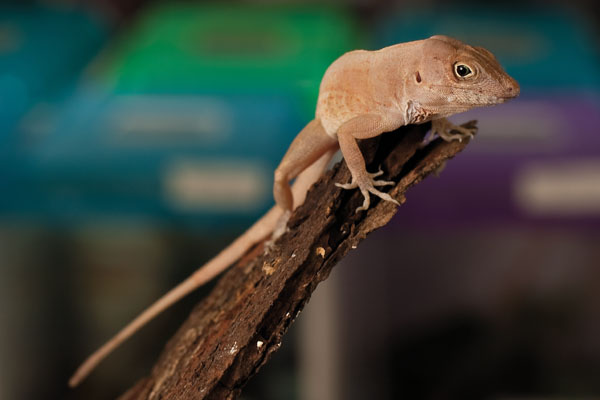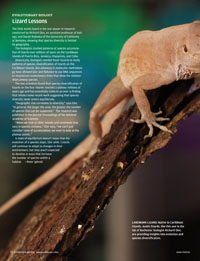In Review
 LANDMARK LIZARD: Native to Caribbean islands, Anolis lizards, like this one in the lab of Rochester biologist Richard Glor,
are providing insights into evolution and species diversification. (Photo: Adam Fenster)
LANDMARK LIZARD: Native to Caribbean islands, Anolis lizards, like this one in the lab of Rochester biologist Richard Glor,
are providing insights into evolution and species diversification. (Photo: Adam Fenster)The little Anolis lizard is the star player in research conducted by Richard Glor, an assistant professor of biology, and Daniel Rabosky of the University of California at Berkeley, showing that species diversity is limited by geography.
The biologists studied patterns of species accumulation of lizards over millions of years on the Caribbean islands of Puerto Rico, Jamaica, Hispaniola, and Cuba.
Historically, biologists needed fossil records to study patterns of species diversification of lizards on the Caribbean islands. But advances in molecular methodology have allowed Glor and Rabosky to use DNA sequences to reconstruct evolutionary trees that show the relationships among species.
The two scientists found that species diversification of lizards on the four islands reached a plateau millions of years ago and has essentially come to an end—a finding that refutes some recent work suggesting that species diversity never enters equilibrium.
“Geographic size correlates to diversity,” says Glor. “In general, the larger the area, the greater the number of species that can be supported.” The research was published in the journal Proceedings of the National Academy of Sciences.
“When we look at other islands and continents that vary in species richness,” Glor says, “we can’t just consider rates of accumulation; we need to look at the plateau points.”
A state of equilibrium doesn’t mean that the evolution of a species stops, Glor adds. Lizards will continue to adapt to changes in their environment, but they aren’t expected to develop in ways that increase the number of species within a habitat.
—Peter Iglinski

